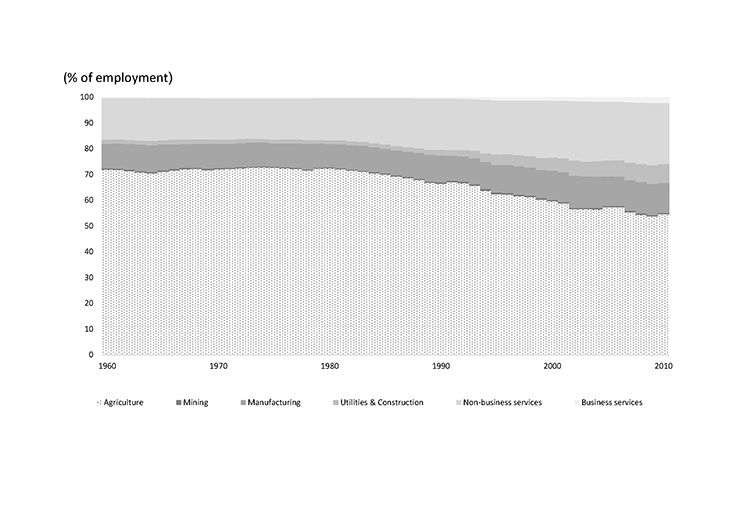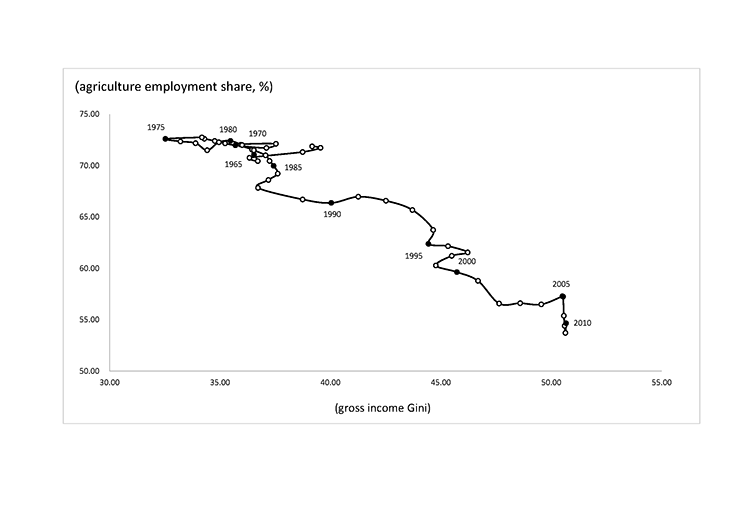Blog
The developer’s dilemma in India – the role of politics and economic ideology
Policy makers seeking inclusive growth frequently face the developer’s dilemma between prioritizing structural transformation, which is potentially inequitable, and keeping a check on rising economic inequality. How this dilemma is resolved by different countries and what factors influence the choices made, are important research questions.
In a new working paper, we analyse the Indian developmental experience since independence. We identify two episodes (1960–80 and 1980–2010) during which distinctly different approaches to resolving this dilemma were deployed. We establish that this difference is explained by political factors and the prevailing economic ideology, which, in turn, drive both policy regimes and economic outcomes. We analyse the dilemma in the context of the Indian developmental experience.
We first look at the nature of the structural transformation in the economy, and then we examine the tradeoff between structural transformation and inequality. Figure 1 shows the composition of employment in the various sectors since 1960.
Figure 1: Employment composition, India, 1960–2010 (% of employment)

We find that between 1960–2010, the share of agricultural employment fell from 71.8% to 54.6%. But overall, India displayed limited manufacturing industrialization with a stronger shift towards an economy dominated by the services sector. The share of manufacturing employment increased only slightly from 9.6% in 1960 to 11.5% in 2010. The two sectors that showed a significant increase in employment share were utilities and construction, and non-business services. The former grew from 1.6% 1960 to 7.4% in 2010, while latter grew from 16.1% in 1960 to 23.6% in 2010.
Figure 2 demonstrates the relationship between structural transformation and inequality since 1960. Until 1980, employment shares in the agricultural sector and inequality both remained largely unchanged. After 1980, non-agricultural employment shares begin to rise.
Figure 2: Gross income Gini and agriculture employment share, India, 1960–2010

In the first episode (1960–80), the economic regime kept inequality under control and this resulted in very little structural transformation and growth in the economy. In the second episode (1980–2010), there was significant structural transformation and growth, but also large increases in inequality.
We characterize these two episodes as ‘inclusion without growth’ and ‘growth without inclusion’ respectively. We then establish that the different outcomes in these two episodes can be explained by political factors and the prevailing economic ideology amongst policy makers, which in turn, drove both policy regimes and economic outcomes.
Two episodes: politics and economic ideology
During the first episode, there was a gradual erosion of the popularity of the political behemoth, the Indian National Congress, which finally lost its electoral majority towards the end of this episode in 1977. This erosion was characterized by increasing political competition, with the ruling political party looking for new political narratives to regain its popularity.
The prevailing economic ideology was strongly influenced by theories of export pessimism and import substitution. A combination of these two factors — the search for a new political narrative and an ideology that was suspicious of privatization and globalization — led to an extremely dirigiste, or interventionist, policy paradigm. The objective of policy was to achieve greater economic inclusion through a regulated industrialization. This policy paradigm was very successful in preventing an increase in inequality, but completely unsuccessful in bringing about any significant structural transformation in the economy.
As politics became even more competitive with the emergence of regional parties, money in politics began to play a bigger role. Political parties in India became much more pro-business as a result and the economic ideology evolved during the second episode towards more liberalization and globalization. The result was significant structural transformation and growth in the economy.
Intense political competition, however, prevented any reforms of the factor markets, particularly land and labour markets. Manufacturing growth and low-skilled employment creation to absorb surplus labour was hampered and the possibility of more inclusive growth during this episode was limited.
Lessons from the developer’s dilemma
From the two episodes discussed above it may seem like there are only two extreme options — either control inequality and sacrifice rapid structural transformation and growth, or prioritize growth and structural transformation at the cost of higher inequality. However, exogenous factors — such as the economic ideology of policy makers and local politics — are what drove the Indian economy towards these extremes. Clearly, the tradeoff was heightened in the Indian case because these factors prevented a structural transformation towards low-skilled employment-intensive sectors like manufacturing, which moderate the dilemma. A key takeaway from the Indian experience is that countries that align their politics and the economic ideology towards developing the manufacturing sector are more likely to achieve inclusive growth.
The future trajectory
Drawing lessons from these two episodes, we speculate about the future trajectory of structural transformation and inclusiveness in the Indian economy. Three possibilities stand out.
First, if the world trade environment is characterized by low global growth and protectionist policies towards developing countries, and together with this, if political competition remains intense in India, then the economic policy paradigm might turn anti-globalization, protectionist, and focused on controlling inequality, much like the first episode described above. This would limit structural transformation and growth, although inequality might remain under control.
Second, if world trade becomes favourable to developing countries, but political competition remains intense in India, with no consensus on land and labour market reforms, then there will be structural transformation, but with limited manufacturing industrialization. This outcome resembles a continuation of the second episode. Since the manufacturing sector usually absorbs low-skilled workers, slower rates of manufacturing growth will continue to lead to higher levels of inequality.
Finally, if future world trade is favourable to developing countries and political competition does not derail a consensus on reforms, then this will enable India to achieve significant structural transformation, but also to enjoy significantly increasing shares of manufacturing industrialization. Higher levels of manufacturing growth will enable more inclusion by creating low-skilled employment, helping policy makers to manage the developer’s dilemma more effectively.
The views expressed in this piece are those of the author(s), and do not necessarily reflect the views of the Institute or the United Nations University, nor the programme/project donors.
 Join the network
Join the network







